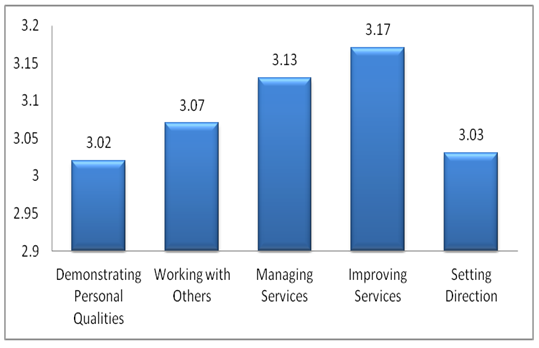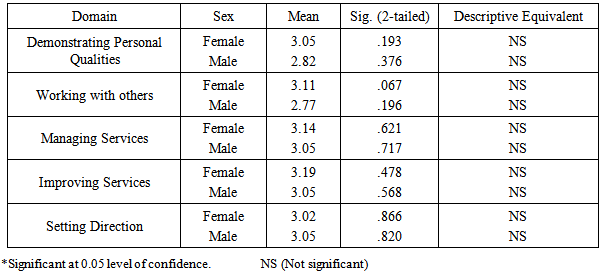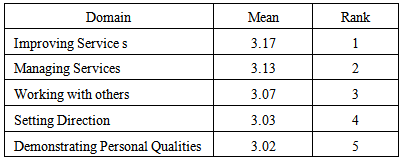-
Paper Information
- Next Paper
- Previous Paper
- Paper Submission
-
Journal Information
- About This Journal
- Editorial Board
- Current Issue
- Archive
- Author Guidelines
- Contact Us
International Journal of Nursing Science
p-ISSN: 2167-7441 e-ISSN: 2167-745X
2015; 5(2): 76-80
doi:10.5923/j.nursing.20150502.06
Self-assessed Clinical Leadership Competency of Student Nurses
Nikka C. Moltio, Lawrence C. Caranto, Juan Jose T. David
College of Nursing, Benguet State University, La Trinidad, Benguet, Philippines
Correspondence to: Nikka C. Moltio, College of Nursing, Benguet State University, La Trinidad, Benguet, Philippines.
| Email: |  |
Copyright © 2015 Scientific & Academic Publishing. All Rights Reserved.
This article is a report on an endeavor conducted to assess the level of clinical leadership competency of level IV student nurses. Articles on nursing leadership are not new, although it is only until recently that clinical nurse leadership has been featured more prominently in health-related literature (Stanley, 2009). Across the globe, the role of clinicians as leaders of health care is viewed as increasingly important. However, only a short series of articles about clinical leadership are present (Swanwick and Mckimm, 2011). An appraisal on the level of clinical leadership competency can aid in recognizing one’s strengths and weaknesses to develop a plan to compensate for one’s limitation. With this study, direction and improvements for clinical leadership may be forwarded to student nurses while they are still in the academe. A self-reporting questionnaire was administered to 74 senior student nurses in the College of Nursing, Benguet State University. Questions were asked to quantify the level of clinical leadership competency of the respondents in the five (5) domains of leadership framework, namely: demonstrating personal qualities, working with others, managing services, improving services, and setting direction. The results revealed that, sex is not a factor in the establishment of clinical leadership competency differences. Also, clinical leadership among student nurses is high in all domains of: demonstrating personal qualities, working with others, managing services, improving services, and setting direction. Furthermore, student nurses are highly competent leaders in the clinical area. Finally, student nurses excel most in the ‘improving services’ domain among the five (5) identified clinical leadership competency subsets. In descending order, it is followed by ‘managing services’, ‘working with others’, ‘setting direction’, and ‘demonstrating personal qualities’.
Keywords: Self-assessment, Clinical leadership, Competency, Leadership framework, Student nurse, Survey
Cite this paper: Nikka C. Moltio, Lawrence C. Caranto, Juan Jose T. David, Self-assessed Clinical Leadership Competency of Student Nurses, International Journal of Nursing Science, Vol. 5 No. 2, 2015, pp. 76-80. doi: 10.5923/j.nursing.20150502.06.
Article Outline
1. Introduction
- The provision of high quality nursing education that emphasizes the highest attainment of professional competencies is one of the goals of Benguet State University-College of Nursing. In order to prepare for the next level of their training, the senior students should possess an appropriate level of competence. Hence, to have a thorough understanding of one’s estate it is essential to conduct a self-assessment so as to make room for improvement. Consistent with the words of Reif (1990) and Wolf [1] (1989), when students are collaborators in assessment, they grow the habit of self-reflection. They learn the features of good work, how to judge their work, how to work to gauge their own struggle and feelings of accomplishment, and how to set individual aspirations. Moreover according to McDonald (2004) [2], self assessment assists students to "learn how to learn". As humans develop, they rely less on the authority of grades and adults' evaluations as sources of feedback on their performance. Rather, self assessment is foundational to the development of intrinsic motivation and autonomous learning.An appropriate definition of clinical leadership competence and its components is important to serve as a criterion for assuring an appropriate level of understanding. Webster dictionary defines being competent as the quality of having sufficient knowledge, judgment, skill, or experience for some purpose. Regardless of the reason, “leadership is influence” as stated by Hersey & Campbell [3] (2004). While leadership is not only restricted to people who hold designated leadership roles, acts of leadership can come from anyone in the organization and as a model, it emphasizes the responsibility of all staff in demonstrating appropriate behaviors (NHS Academy, 2012) [4]. Articles on clinical leadership is not a new concept, although it is only until recently that clinical nurse leadership has been featured more prominently in health-related literature (Stanley, 2009) [5]. Across the globe, the role of clinicians as leaders of health care is viewed as increasingly important. However, only a short series of articles about clinical leadership are present (Swanwick and Mckimm, 2011) [6]. As stated by NHS Academy [4] (2012), clinical leadership in the health care services is about delivering high quality services to clients. Moreover, it is vital to be competent in the 5 core domains of leadership framework namely: (1) demonstrating personal qualities, (2) working with others, (3) managing services, (4) improving services and (5) setting direction (Figure 1).
 | Figure 1. Leadership Framework |
2. Methods
2.1. Design
- In order to ascertain the scheme on the level of clinical leadership of the student nurses, descriptive-quantitative research design was utilized. It allowed the researcher to amass significant information and data objectively through the use of the said design.
2.2. Sampling
- The study was conducted within Benguet State University- College of Nursing and the respondents were selected through total enumeration. There were seventy-four (74) level IV student nurses, where sixty-six (66) were females and eight (8) were males.
2.3. Instrument
- The Clinical Leadership Competency Tool used in this study is published on behalf of the NHS Leadership Academy by NHS Institute for Innovation and Improvement, Coventry House, University of Warwick Campus, Coventry. This survey instrument was used in relation to the content it embraced.The self-reporting questionnaire encompassed two sections, wherein section 1 contained a brief demographic survey of the population to determine the sex of the subjects. Meanwhile section 2 comprised the thirty-five (35) questions, with seven (7) indicators in each domain. The respondents rated each item using a 4-point Likert scale ranging from 1 (very low) to 4 (very high).
2.4. Ethical Considerations
- Participation in the study was voluntary with implied consent assumed with return of the completed survey; meanwhile, there were no risks identified for being included in the study. Advantages from the study include development of leadership, personal styles and abilities, and understanding of how effective leadership impact and benefit patients as they move from being a student to a practitioner upon graduating.
2.5. Statistical Treatment
- The data gathered were organized, tabulated, treated and analyzed using the Statistical Package for the Social Sciences version 20 (SPSS Inc., 2011) [8]. The mean and ranking were used in evaluating the level of clinical leadership competency of level IV student nurses along with the following domains: demonstrating personal qualities, working with others, managing services, improving services and setting direction. In addition, independent sample t-test was utilized to determine if a significant difference exists between the male and female’s level of clinical leadership competency.
3. Results and Discussion
3.1. Clinical Leadership Competency of Male and Female Student Nurses
- Table 1 shows that there is no significant difference between the male and female student nurses’ clinical leadership competency.
|
3.2. Level of Clinical Leadership Competency of Student Nurses in the 5 Domains
- Figure 2 presents that the student nurses weigh up themselves as highly competent clinical leaders in the 5 identified subsets of clinical leadership competency.
 | Figure 2. Level of Clinical Leadership Competency of Student Nurses in the 5 Domains |
3.3. Level of Clinical Leadership Competency of Student Nurses
- Table 2 reveals that the overall clinical leadership competency of the subjects gained a mean of 3.081 which is neither less than 2.5 nor greater than 3.25 suggesting that student nurses regard themselves as highly competent clinical leaders.
|
3.4. Comparison of the 5 Domains of Clinical Leadership Competency
- Table 3 presents which domain among the 5 identified subsets of clinical leadership competency does the student nurses excel in the most, denoting that the domain the student nurses perceive themselves to excel the most is ‘improving services’. This is in agreement with Sullivan (2009) [14] who stated that clinical leaders are the translators of organizational approaches to quality and plays a major role in identifying priorities for improvement, establishing and maintaining quality standards, and assuring that improvements are evaluated for safety, efficacy, and effectiveness.
|
4. Conclusions and Recommendations
- Anchored on the findings of the study, the following conclusions were drawn:Sex is not a factor in the establishment of clinical leadership competency differences. Also, clinical leadership among student nurses is high in all domains of: demonstrating personal qualities, working with others, managing services, improving services, and setting direction. Furthermore, student nurses are highly competent leaders in the clinical area. Finally, student nurses excel most in the ‘improving services’ domain among the five (5) identified clinical leadership competency subsets. In descending order, it is followed by ‘managing services’, ‘working with others’, ‘setting direction’, and ‘demonstrating personal qualities’.Based on the conclusions of the study, the following recommendations were derived:The inclusion of clinical leadership in the early stages of basic nursing education and training. Assimilate findings on NCM 106: Leadership and Management, for a better and broader understanding on the importance of clinical leadership as future practitioners.The findings may be utilized by the faculty in improving the clinical leadership competence of student nurses. The following are recommended for future study: (1) a study be conducted on the same line by increasing the target number and population, (2) a self-assessed clinical leadership competency for the faculty members, (3) an instructor-assessed clinical leadership competency among the student nurses, (4) a comparison on the leadership competencies of the students, considering the 4 year level differences.
ACKNOWLEDGMENTS
- The authors wish to convey their sincere gratitude and respect for all those who have been indispensable in completing this study. To their families and friends, especially Ms. Rencel Finnos V. Sabog, who provided immeasurable support and guidance throughout the course of this research. They also extend their utmost appreciation to Mr. Keverne Jhay P. Colas for his valuable insights for the refinement of this study.
 Abstract
Abstract Reference
Reference Full-Text PDF
Full-Text PDF Full-text HTML
Full-text HTML

